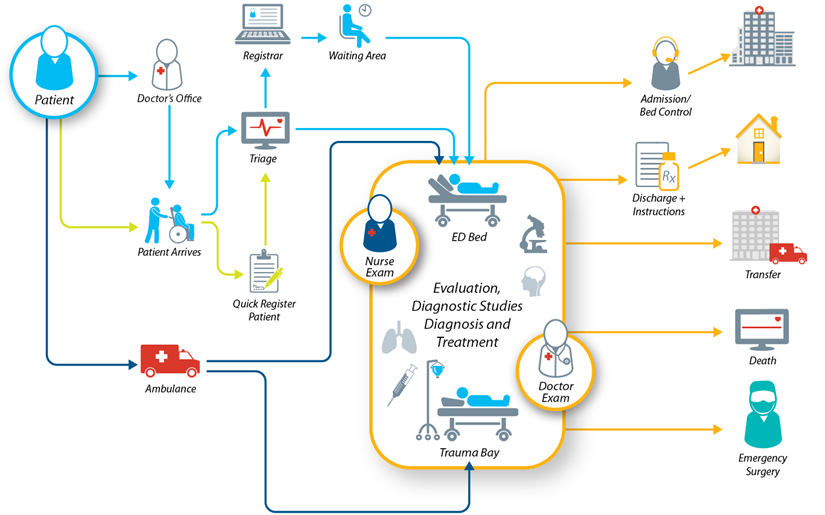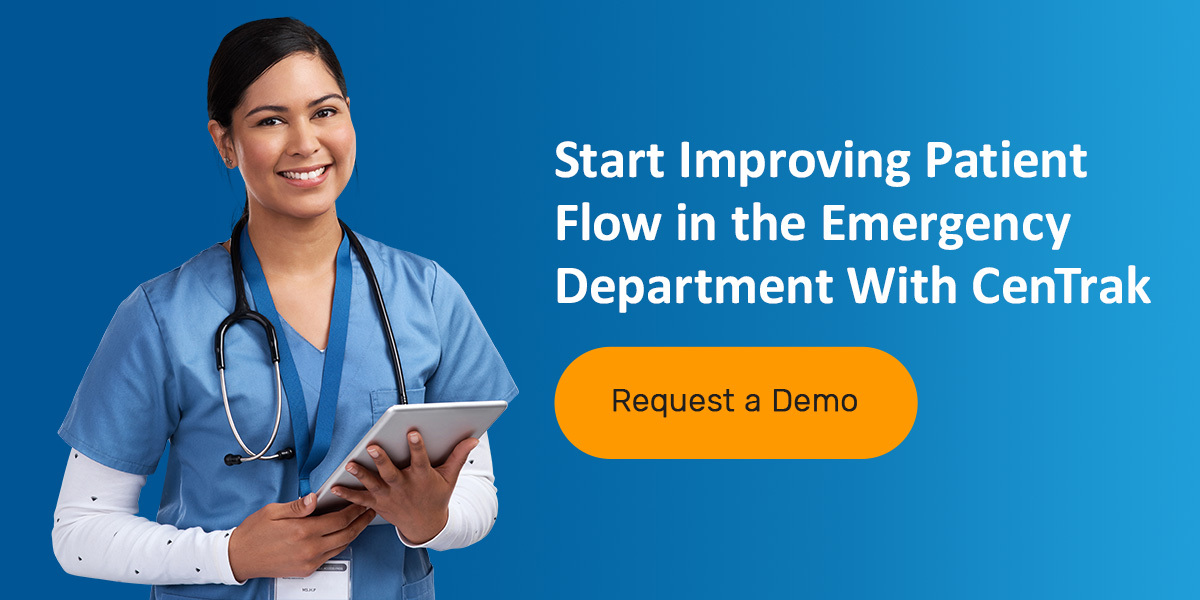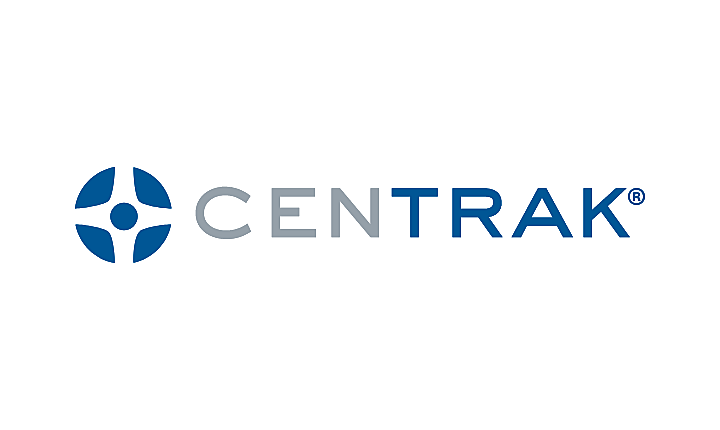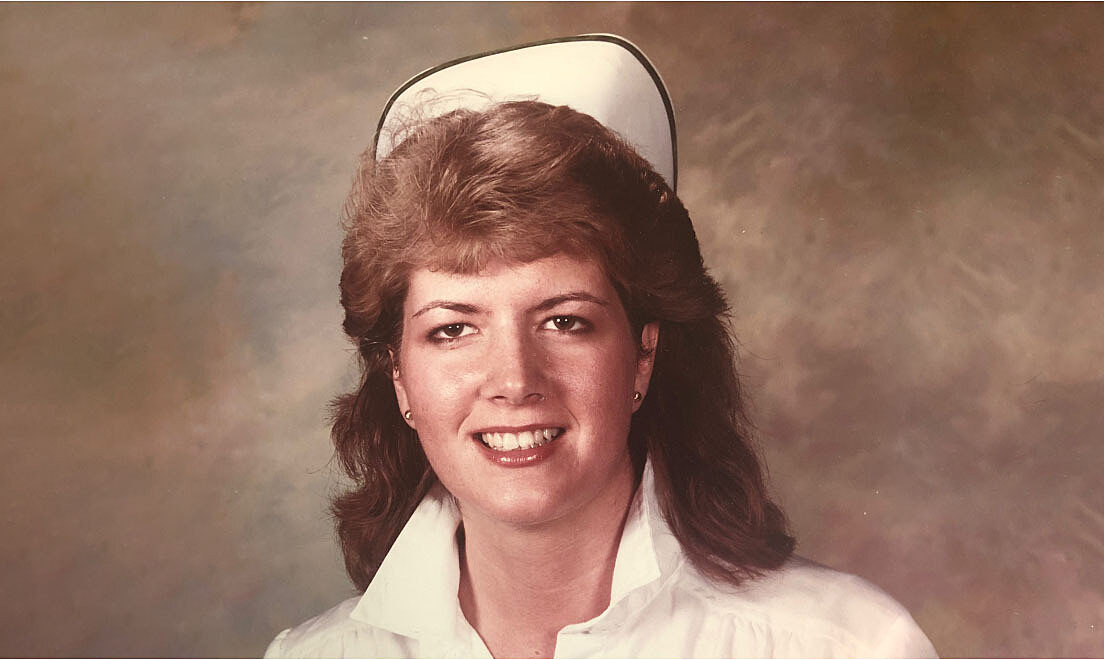Optimize Patient Flow in the Emergency Department

The Emergency Room is one of the most active departments within a hospital. Patients come in at all times of the day and night with various illnesses or injuries. Throughout the various scores of events that take place, from Triage to departure, patients are moved around and seen by numerous hospital caretakers to determine their condition.
With the workload of staff increasing and the importance of patient experience and satisfaction rising, it is imperative for hospitals to create more streamlined processes that eliminate wasted time and steps within the Emergency Department.
Implementing Real-Time Locating Systems (RTLS) for hospital staff, patients, and assets eliminates various manual processes and enhances patient flow for better patient care.
CenTrak is reinventing the standard of healthcare delivery with our RTLS and Environmental Monitoring solutions.
Patient Flow in the Emergency Department
Efficiently moving patients within the emergency department involves several factors, from decision-making to internal systems. Meeting patients' needs quickly and effectively by ensuring they easily move through different phases of care is necessary for proper emergency department flow. It is also essential for overall patient safety and quality of care.
Factors that Impact Emergency Department Flow
The emergency department sees an influx of patients daily, often leading to overcrowding and staff burnout. A few factors that impact poor patient flow are:
- Limited resources for tending to patient needs.
- Little to no communication with patients or among staff.
- Inefficient scheduling that leads to bottlenecks in the workflow.
- Complex and time-consuming processes.
- Lack of visibility into patient location, status, and condition.
Patient Flow Improvement Strategies
While the emergency room is bound to be busy and filled with patients, it is still possible to improve patient flow and the efficiency of operations. One of the best ways to achieve that is by tackling factors such as poor communication and lack of visibility with RTLS devices. Here is how this clinical workflow solution can help:
Staff Location
RTLS Staff badges identify the location of staff throughout the ED, which can improve efficiency. Badges provide staff presence validation, streamline workflow, and display location via maps on AV monitors with accessible viewing for staff. Locating the staff's whereabouts eliminates time spent searching for caregivers, automates documentation, and provides administrators with strategic insights that can help to improve processes, like resource allocation to better support staffing strategies. Accurate location data also helps to support staff in the event of patient disputes.
Nurse call integration with RTLS can help improve response times and reduce administrative burden on clinical staff. A clinical-grade RTLS platform consistently identifies when a team member, equipped with an RTLS-enabled badge, enters the patient's room or bay. It then automatically cancels the alert, automatically records the response time, and activates the dome light to communicate staff presence.
In addition, the call functionality on the staff badges enables staff members in duress to discreetly request help with a simple press of a button. The technology instantly communicates the staff member's details and precise whereabouts. Protecting staff from workplace violence in the emergency department reduces incidents that could lead to psychological distress and job dissatisfaction while encouraging better patient care.
Patient Location
Patient wearables help monitor where a patient is at all times. RTLS wearables can help expedite patient response times and optimize the patient flow process with automatic notifications of extended wait-times or process breakdowns. Staff can observe patient locations and waiting times through monitors at workstations to proactively communicate with patients who may be experiencing delays in care.
The wearables also help staff locate wandering patients who leave bays or rooms without approval and get them back where they need to be. Properly managing wandering patients ensures their safety and the staff's ability to provide quality care, resulting in better workflow.
The movements of each patient (from entry into the ER, admittance into the hospital, until departure) are automatically updated to their electronic record with the exact dates and times for hands-free documentation.
Equipment and Asset Tracking
When staff are under pressure, they don't have time to waste running around looking for patient monitors, IV pumps, or other equipment. With asset tags, equipment in the ED is tracked to show its exact location for immediate recovery and use. During critical cases, essential supplies and mobile medical equipment need to be located immediately for patients, with no time to spare. Asset tracking can capture exchanges between equipment within just a few seconds, knowing which assets are in use, available, or in need of maintenance, speeds up the workflow processes to provide faster, better care for patients.
Start Improving Patient Flow in the Emergency Department With CenTrak
The integration of RTLS within the Emergency Department is thorough in advancing workflow processes and patient flow. It enhances staff communication and gives more visibility of patients in a fast-paced environment where time matters.
CenTrak offers effective patient flow solutions to increase hospital efficiency and help you provide better patient care and experiences. Request a demo to get started.






